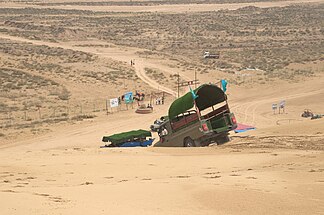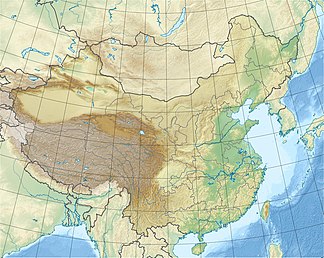Kubuqi desert
| Kubuqi desert
Kubuqi Shamo (库 布 其 沙漠)
Hobq Shamo |
||
|---|---|---|
| location |
|
|
| part of | Ordos desert | |
|
|
||
| Coordinates | 40 ° 0 ′ N , 109 ° 0 ′ E | |
| rock | loose sand (61% shifting dunes) | |
| surface | 17,000 km² | |
The Kubuqi Desert ( 庫 布 其 沙漠 / 库 布 其 沙漠 , Kùbùqí Shāmò ) is a sand desert in Inner Mongolia in China . It is located on the northern Ordos Plateau , south of the Hetao area at the great bend of the Huang He River.
description
The Kubuqi Desert borders the south bank of the Yellow River, which surrounds it on three sides to the west, north and east. There it extends from west to east over an approximately 300 km long strip, the width of which decreases from initially 100 km to 20 to 30 km. It is around 1,100 m above sea level on the northern Ordos Plateau and is therefore part of the higher Ordos Desert . With an area of around 17,000 km 2 , it is the seventh largest desert in China. It is the only active dune field in the semi-arid northern regions of the country. 80% of the up to 100 m high dunes are active. The sickle dunes lie across the main wind direction WNW and move about 10 m annually from west to east.
The desert region is quite dry, very windy and mostly cold. There is a moderate continental monsoon climate with 240 to 360 mm / a precipitation and 2,160 mm / a potential evaporation. The temperatures are characterized by brief summer heat and cold winters. The extreme temperatures are a maximum of 40.2 ° C and a minimum of -34.5 ° C. There are on average only 58 frost-free days a year. The wind speed averaged over the year is 3.3 m / s (12 km / h) with a maximum of 30 m / s (108 km / h) with a total of 27 days of storm time, mainly in the period from April to May. There are 15 rivers and there are plenty of groundwater.
Little is known about the age and origin of this sandy sea. Geomorphological and stratigraphic observations indicate that the Holocene Aeolian sand often rests on rock and river terraces and forms a palimpsest-like landscape. The last reactivation of the sands took place in the period from 2200 to 1100 years ago, triggered by agriculture and livestock. There are some abandoned settlements from this era in the Kubuqui Desert. Changes in the discharge of the Yellow River and withdrawals for irrigation also contributed to the expansion of the dune field.
Due to severe sandstorms, the Kubuqi Desert is the main source of airborne dust in Inner Mongolia and the greater Beijing area. Many yellow sand storms even reach South Korea and occasionally even the USA. The regional government began a reforestation program in 1988 with fast growing and commercially productive poplars. By the end of 2014, forests had been created on a total area of 1,361 km 2 .
See also
Web links
- Green barriers against the desert
- Change in the Kubuqi desert on german.cri.cn
- Kubuqi desert turns into numerous oases . Web article from the state-affiliated China Internet Information Center with current images of the change in the desert (German)
Individual evidence
- ↑ a b Rao, Wenbo, et al. "Sr-Nd isotopic characteristics of eolian deposits in the Erdos Desert and Chinese Loess Plateau: Implications for their provenances." Geochemical Journal 42.3 (2008): 273-282. ( PDF )
- ↑ You, Heqiang, Xian Xue, and Tao Wang. "Estimation of saltation emission in the Kubuqi Desert, North China." Science of the Total Environment 479 (2014): 77-92. ( PDF )
- ↑ a b Cui Yan. "Image Interpretation and Dynamic Analysis of Desertification of Kubuqi Desert." Bulletin of Soil and Water Conservation 30.6 (2010): 100-102. (Chinese, PDF )
- ↑ a b c d e f Yang, Xiaoping, Forman, Steven, Hu, Fangen, Zhang, Deguo, Liu, Ziting, Li, Hongwei. "Initial insights into the age and origin of the Kubuqi sand sea of northern China." Geomorphology (2016), doi : 10.1016 / j.geomorph.2016.02.004 ( online )
- ↑ a b c d e Akiko Fuse. "Greening in the Kubuqi Desert, China - The relationship between growth of Populus simonii and depth of sedimentary sand." Tohoku Journal of Forest Science 4.1 (1999): 25-29. (Japanese, PDF )
- ↑ Yang Guang, Li Qinghe. "Spectral characteristics of artificial biological crust of desert alga in the east edge of Kubuqi Desert." Science of Soil and Water Conservation 12.1 (2014): 90-95. (Chinese, PDF )
- ↑ a b Wang, Liming, et al. "Response of surface temperature to afforestation in the Kubuqi Desert, Inner Mongolia." Journal of Geophysical Research: Atmospheres 123.2 (2018): 948-964. doi : 10.1002 / 2017JD027522 ( PDF )
- ↑ Everything yellow. Sandstorm over China , ntv, March 20, 2010

